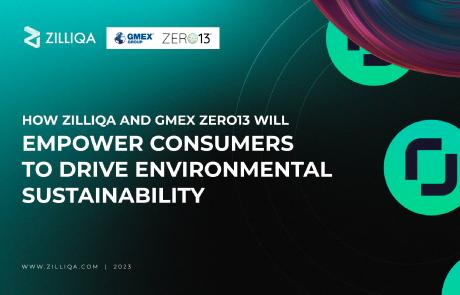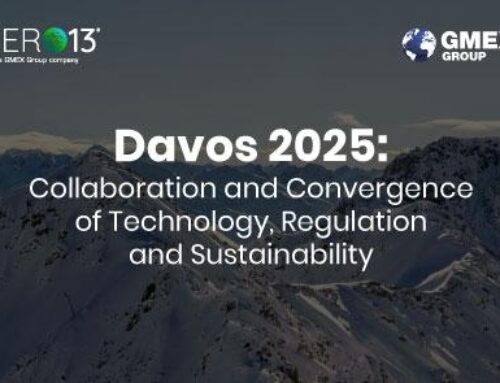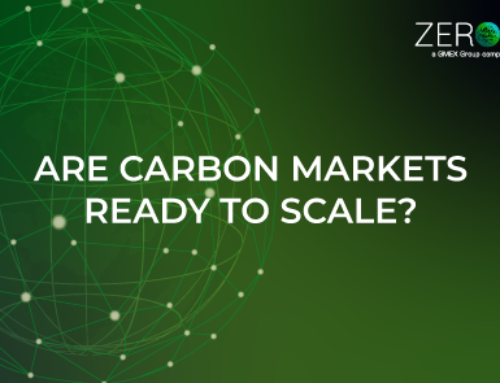We spoke to GMEX Group and ZERO13 Chairman and CEO Hirander Misra about the new carbon offset platform powered by Zilliqa.
Zilliqa Group and GMEX Group by way of its initiative ZERO13 recently announced a partnership that leverages the ZERO13 digital climate fintech aggregation ecosystem to launch a new carbon offset platform that gives consumers the power to offset their carbon footprints and contribute to environmental sustainability.
ZERO13 is an automated AI and blockchain-driven international carbon exchange, registry and multi-participant aggregation hub, and asset settlement ecosystem. This partnership between Zilliqa and ZERO13 will deliver a carbon offset platform that will allow consumers to receive EVP tokens for making purchases from brands partnered with Zilliqa and integrated with the platform.
These EVP tokens allow consumers to offset the carbon footprint of their purchases, giving end-users control over which carbon-credit offset initiatives are supported by their buying activity. The tokens also include programmable features such as expiry conditions which encourage holders to direct them towards carbon offset projects in a timely manner.
This first-of-its-kind carbon offset platform built on Zilliqa and ZERO13’s infrastructure is poised to revolutionise the often opaque and inefficient marketplace for carbon credits while also allowing brands to deliver a transparent and accountable record of their environmental sustainability efforts thanks to the immutable nature of blockchain technology.
To find out more about this new carbon offset platform and how it empowers consumers to drive environmental initiatives together with their favourite brands, we spoke to GMEX Group and ZERO13 Chairman and CEO Hirander Misra.
What are carbon credits?
Carbon credits are transferable representations of efforts to reduce or avoid greenhouse gas emissions. They can be purchased by companies which emit greenhouse gases to offset their operational emissions by funding projects that reduce or remove emissions.
“There are companies that emit greenhouse gases as part of their operations, and those companies can purchase carbon credits to offset their emissions,” Hirander explains.
“One carbon credit is equivalent to one tonne of carbon dioxide emissions, so for example if a company was emitting one tonne of carbon dioxide, they would need to buy one carbon credit to offset their emissions.”
“But equally there are companies both through carbon avoidance or reduction that are saving on greenhouse gas emissions. This could be an oil company that improves the efficiency of its refineries and reduces flaring, which reduces the amount of greenhouse gas emissions, and that reduction might relate to a carbon reduction credit.” Hirander adds.
On the other hand, carbon credits for removal or avoidance of emissions relate to initiatives such as renewable energy generation or the replanting and preservation of trees rather than felling them for wood.
Overhauling a fragmented marketplace with ZERO13
There is no global marketplace for carbon credits, as at the moment it is fragmented and often beset with inefficiencies created by the disproportionate returns earned by certain brokers that facilitate the sale of credits between carbon offset projects and other businesses.
“The market is very fragmented. There are multiple ways to buy carbon credits, but 95% of it is what we call over the counter, which means I am trying to find a buyer if I am selling and you are trying to find a seller if you are buying. It is very bilateral and antiquated and there are a plethora of standards in terms of carbon credit supply, but there is no global consistent pricing mechanism,” Hirander says.
“The opacity of this can lead to quite large profits for middlemen, who are not all inherently bad as they can add liquidity to the market in a good way.”
“But to give an example, say there is a community-driven project on bio waste in India. The credits generated by this project are being sold for $3 by the project developer to a broker in London, who is then selling them to another broker for £7 and that broker is selling them to the client for reducing their emissions at £9, which would lead to the project developer only getting $3 and the brokers profiting substantially,” he says.
The solution to this problem is the introduction of a digital aggregator that integrates traditional financial solutions and blockchain technology to deliver a healthier market for carbon credits that more effectively connects buyers and sellers while ensuring transparency and accountability.
“That is where the transparency with blockchain and the ability to in a distributed manner bring together disparate forms of supply and demand for trading will really help this market,” Hirander says.
“Brokers and middlemen can continue to function, but then there will be a more equal distribution of wealth back to the community.”
When they first looked at launching the ZERO platform-as-a-service marketplace, Hirander and the GMEX team realised the need for capable infrastructure to underpin any products they would create within this marketplace to ensure that it would leverage the best aspects of traditional and decentralised finance.
“We realised our approach to digital assets had to be hybrid, which is a combination of TradFi, CeFi, and DeFi, and it had to be a network of networks approach, much like an example of Zilliqa coming together with us for this initiative,” Hirander says.
“Our core business is enabling exchanges all over the world, and we started getting approached by governments and entities asking us to set up a carbon exchange. When we looked at it, we said this is putting the cart before the horse, because that whole construct that I’ve described which is broken needs to be addressed before the liquidity can come on to an exchange as the buyers may be in one country and the sellers in another.”
“We realised that we could take a lot of the work that we had done on the hybrid finance and digital asset side and repurpose it to these markets, so we created ZERO13 about a year ago. ZERO13 connects multiple registries that hold these assets, multiple custodians that service these assets, multiple exchanges that offer these assets to trade, and multiple participants that can trade these assets either in their own right or on exchange, as well as consume multiple services. It’s an aggregator that can be both distributed and connected via API, but also more decentralised by integrating with multiple public and private blockchains,” Hirander says.
ZERO13 paves the road for new ways to interact with the carbon credit market by essentially aggregating a marketplace for carbon credits across multiple disparate blockchains and traditional marketplaces.
“Ultimately it provides a platform that is a bit like Stripe for ESG, where if you want to use one registry or one standard that is great, but then someone else can use another one and it is your choice what you supply and what you buy and trade,” Hirander says.
“Under that we have a layer-two network which connects to multiple blockchains but also acts as an escrow to lock in assets and make those available to trade, while allowing for settlement as well.”
A game-changing partnership with Zilliqa
The nature of the partnership between Zilliqa Group and GMEX finds its roots in the approach Hirander and Zilliqa Group Chairman Mark Hemsley took when they worked in co-opetition to revolutionise equities trading in the late 2000’s.
“Mark and I have a really strong history going back to about 2005 because we were in co-opetition when that whole revolution in trading venues came about with a different way to trade. And we are at a similar inflection point, but ten times magnified now,” Hirander says.
“When Mark was at what was then Lehman Brothers and I was at Instinet, we were talking about how we could revolutionise equities trading that was beset with problems, and we worked in our own right but also through cooperation to solve that problem with the incumbent way of doing things.”
“The way this carbon offset platform came about was we noted that, for example, you book a flight and then on the flight booking it asks if you want to offset your carbon emissions. There might be a QR code and that might lead you to launching an app. But you have no idea where your money goes or what you are buying,” he adds.
“The great thing about blockchain is it can democratise the way that we deal with finance and decisions. That current system doesn’t really incentivise you to offset because a tiny percentage of people catch a flight and actually click on that option, so we said thought it would be great if brands could through a form of loyalty give their own users a role in the decision-making process where they can choose the types of projects to support.”
This approach birthed the idea for a carbon offset platform built in partnership with Zilliqa using the EVP token, which allows both consumers and businesses to benefit from a more transparent and meaningful method of furthering environmental sustainability.
“It is a great way for brands working closely with their consumers to be able to drive net zero together, which is good for the brand and for the consumer as well. It is a great way of bringing together the B2B side and the B2C side in a really cohesive manner and to scale that in a way that really demonstrates the change in approach in the market,” Hirander says.
He adds that partnering with Zilliqa Group to deliver this platform is an exciting opportunity thanks to the Zilliqa network’s approach to interoperability and the range of clients and brands building on the blockchain.
“For us we absolutely subscribe to a multi-chain approach and the ability to scale the market. I like what Zilliqa is doing because there are a number of things that can lead to even more change as we take this partnership forward. There are a lot of things now being interconnected, whether that is in anything from metaverse to gaming,” Hirander says.
“What I like about Zilliqa is its multi-chain approach but also as a core blockchain it is trusted, there are a range of brands building on it, and there is familiarity as we have been looking to do something with Zilliqa that is game-changing for quite some time.”
Empowering consumers to deliver real change
EVP tokens can be automatically earned through purchases from brands that have partnered through the Zilliqa-based carbon offset platform, being earned in a similar way to traditional loyalty points while empowering consumers to hold brands and themselves accountable for their carbon footprints.
“Brands and their consumers are already very familiar with loyalty and reward, I mean we deal with that even if we book a flight and we earn Avios, for example,” Hirander says.
“Now instead, based on consumer behaviour and revenues, brands can have an allocation mechanism for EVP tokens, which works in much the same way as loyalty, but that is then money based on consumer revenue that is allocated to community carbon offset projects.”
“This is fantastic because as consumers and brands we are now being responsible. It is not just about consumerism and revenues; a proportion of that is now being allocated automatically for good,” he says.
By integrating with this new carbon offset platform, companies can also bypass the opaque traditional carbon credit marketplace and give their consumers clear insight into where their environmental sustainability efforts are being focused.
“You can now see what is happening – it is immutable on the blockchain. You have a choice in the types of projects you want to support and you know that it is actually doing good rather than trusting what we say as given. That ensures the whole system has integrity and trust from end to end, which is going to then help drive more brands to the platform to utilise the same approach.” Hirander explains.
“That is great for the Zilliqa ecosystem, but more broadly our multi-blockchain aggregation layer allows us to take a co-opetition approach because we can integrate with other ecosystems and create a movement that is democratised and involves consumers and brands that operate across blockchains.”
“Of course, the first-mover advantage and the ability to harness this in partnership with Zilliqa puts us in a great position collectively,” he says.
With COP 28 on the horizon, public awareness of the climate crisis is higher than ever, and many are looking for more ways to ensure that companies are being held accountable for their emissions, as well as ways to reduce their own carbon footprints.
“Ultimately, we have seen unprecedented flooding, storms, drought and other events around the world, and I think everyone is beginning to realise that these climate events are not just a coincidence. We are beginning to see the impact of climate change play out in our day-to-day lives,” Hirander says.
“If we talk about snake people and Gen Z, they are very conscious about this, and on the other side as well, every finance event I attend looks at the importance of how climate responsibility and finance can go together enabled by technology.”
“This is where it is worth talking about pillars to address action on climate change, namely financial innovation, technological enablement, training and education, and policy and regulation. Our carbon offset platform is touching on multiple pillars, which is great as I know as a consumer that a particular brand using this platform will deliver change on my behalf which I might not have the capacity to deliver in my own right,” Hirander adds.
At COP 28, Hirander is excited to showcase the potential of this new carbon offset platform in partnership with Zilliqa during the event.
He also challenges those who are attending the event via private jets and other entities looking to offset the carbon footprint of their contribution to the conference to consider a transparent mechanism powered by the Zilliqa blockchain and verifiable by the global public.
“We are working with Zilliqa on a tangible demonstration with real activity for COP 28, showing this platform working in a way that can scale,” Hirander says.
*People will also fly into COP 28 on planes from all over the world and governments hosting these conferences need to offset their carbon footprints – we have the perfect mechanism for these entities to do that and prove their offset to people around the world through the transparency of a public and immutable blockchain.”
(Source: Zilliqa)



